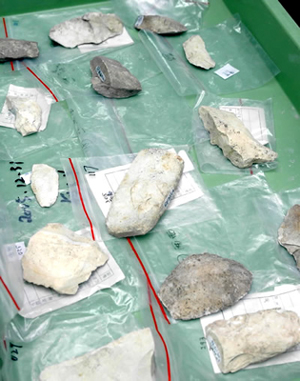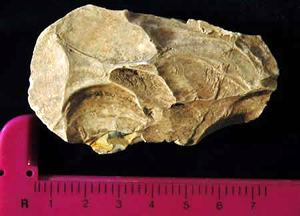|
As Asia's trade and finance hub born out of small fishing villages in less than 200 years, Hong Kong is far less attractive to archaeologists than it is to businessmen and bankers.
A newly-discovered ancient quarry at Sai Kung in eastern Hong Kong, however, has roused interests of anthropologists, who announced Saturday that the human history on the territory can be traced back to 30,000 years ago rather than the conventionally-believed 6,000 or 7,000 years ago.
F ield excavation and sample studies showed that irregularly-shaped stones found at the site were actually manufactured products of human beings of the Paleolithic era, ranging from 35,000 to 39,000 years before present, Steven Ng, vice-chairman of the Hong Kong Archaeological Society, told reporters. ield excavation and sample studies showed that irregularly-shaped stones found at the site were actually manufactured products of human beings of the Paleolithic era, ranging from 35,000 to 39,000 years before present, Steven Ng, vice-chairman of the Hong Kong Archaeological Society, told reporters.
Thousands of lithics unearthed along a sea-facing slope of the Wong Tei Tung Hill and from the underneath pebble-covered beach also suggested that the 400-meter-long and 100-meter-wide site was a quarry of antiquity.
The significance of the discovery lies in the fact that, as the only discovery in Hong Kong from the Paleolithic era, it changes the traditional view that Hong Kong had no human activity until the Neolithic era, Professor Zhang Senshui told Xinhua.
Zhang is a prominent expert in Paleolithic stone tools and a Senior Advisor of the Archaeological Group of China's State Bureau of Cultural Relics.
The "oldest and most important archaeological site" in Hong Kong, however, was discovered by accident by Ng and his collage fellow Wong Fu, when fishing on the beach in the Sai Kung Country Park in the spring of 2003.
Though looked natural in laymen's eyes, the stones seemed special to Ng and Wong -- neither smooth waterworn pebbles nor coarse angular cobbles fallen from the hill. The stones also seemed to have been processed to some particular shape.
By professional acumen, Ng brought the stones to the neighboring Guangdong Province to seek advice from his mentor professor Zhang Zhenhong and thus unveiled the Wong Tei Tung site.
In the following two years, an initial investigation has unearthed over 7,000 lithics densely existing at the site.
According to preliminary examination of 156 pieces, the artifacts have been classified to nine categories, namely, short axe, scraper, point, hand-axe, chopper, arrow-like lithic, awl-like lithic, pick and burin.
"Such a scale of Paleolithic antiquity has never been seen not only in Hong Kong, but neither in the Pearl River Delta and even the whole southeastern coastal area of China," said Zhang Zhenhong.

Judging from the scale and quality of the unearthed artifacts, archaeologists are expecting more to be unearthed from the Wong Tei Tung site, which might help to complete jigsaws of human activities in China's southeastern coastal area some 30,000 years ago. ...
A dozen sites of the Paleolithic era have been discovered over the past three decades around the southeastern coastal areas panning the Chinese provinces of Zhejiang, Taiwan, Fujian and Guangdong.
The discovery at Wong Tei Tung in Hong Kong once again reminds experts of studying early human history in this region from a comprehensive point of view.
"The large quantity and unique skills used at the site couldn't be a single phenomenon," said Zhang Senshui. "It put forward new topics to anthropologists to find links between the separate human activities around different sites (in the region) in terms of space and time."
Taking hand-axe found at Wong Tei Tung as an example, Zhang noted that the same stone tools have been found at various Paleolithic sites from Europe, India to China's southeastern coast.
Preliminary study already showed the hand-axes at Wong Tei Tung were different from those found in Europe and India, but more research has to be done to decide whether it is the same type of those discovered in other parts of China.
"Are they (hand-axes of Wong Tei Tung) results of exchange of human activities of different cultures or the continuation of as kill belonging to the same culture?" asked Zhang.
"We know too little of the region's natural history in the period of 30,000 years ago, and need do more sample tests to draw a conclusion," he said.
Meanwhile, many questions of Wang Tei Tung itself have yet to be answered, besides the fact that the quarry's age has been confirmed by the skill of optical luminescence dating.
Though a large number of lithics have been unearthed here, not a single piece of fossil has been found at the site. Thus, archaeologists still have no idea of what human activities looked like around the place in the Paleolithic era.
Was the place only a quarry far away from human's residence some 30,000 years ago, or had any clue of human inhabitancy here been washed away into the ocean thousands of years ago?
At a test pit dug out along a slope terrace, archaeologists discovered both 30,000-year-old lithics and those of only 6,000 years of history. Between the two layers of discovery, laid a blank of nothing.
What occurred between the two periods? And why human activities reappeared at the same site after any signs of them vanished here for tens of thousands of years?
On the current stage of investigation, if any answer was given to the above questions, they could be only bold guess, said Zhang.
Despite the professional prudence, the 75-year-old archaeologist admitted the importance of challenging conventional beliefs.
"The traditional belief that human history started 6,000 years ago in Hong Kong can partly explain the late discovery of Wong TeiTung site in such a densely-populated city," he said.
|